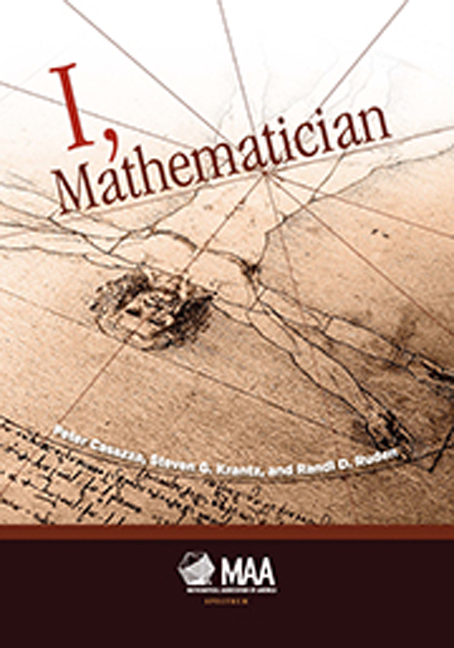Book contents
- Frontmatter
- Contents
- Preface
- Part 1 Who Are Mathematicians?
- Part II On Becoming a Mathematician
- Foreword to On Becoming a Mathematician
- 11 Mathematics and Teaching
- 12 Who We Are and How We Got That Way?
- 13 Social Class and Mathematical Values in the USA
- 14 The Badly Taught High School Calculus Lesson and the Mathematical Journey It Led Me To
- 15 The Psychology of Being a Mathematician
- 16 Dynamics of Mathematical Groups
- 17 Mathematics, Art, Civilization
- 18 Questions about Mathematics
- 19 A Woman Mathematician's Journey
- Part III Why I Became a Mathematician
18 - Questions about Mathematics
from Part II - On Becoming a Mathematician
- Frontmatter
- Contents
- Preface
- Part 1 Who Are Mathematicians?
- Part II On Becoming a Mathematician
- Foreword to On Becoming a Mathematician
- 11 Mathematics and Teaching
- 12 Who We Are and How We Got That Way?
- 13 Social Class and Mathematical Values in the USA
- 14 The Badly Taught High School Calculus Lesson and the Mathematical Journey It Led Me To
- 15 The Psychology of Being a Mathematician
- 16 Dynamics of Mathematical Groups
- 17 Mathematics, Art, Civilization
- 18 Questions about Mathematics
- 19 A Woman Mathematician's Journey
- Part III Why I Became a Mathematician
Summary
If a question can be put at all, then it can also be answered.
—WittgensteinWhy Do Humans Even Know That Mathematics Exists?
Archaeological evidence shows that anatomically modern humans appeared about 200,000 years ago. Fully modern human behavior (figurative art, music, trade, and so on) dates back at least 30,000 years. There are two theories regarding the emergence of modern behavior. One is that knowledge, skills, and culture gradually accumulated to a sufficient degree that the behavior of Homo sapiens crossed the metaphorical boundary into modern behavior. The second theory for the emergence of modern behavior is called the Great Leap Forward or, less colorfully, the Upper Paleolithic Revolution. This theory posits a genetic change that led to the development of spoken language and, consequently, to modern behavior. The assumption that a genetic change occurred as required by the Great Leap Forward theory may not be as ad hoc as it seems. In fact, there is independent, scientific evidence of a genetic change related to brain size regulation that occurred at approximately the time of the Great Leap Forward (see [EV]).
Written language was not developed until about 5000 years ago—3000 BCE—so we can only speculate as to what humans were thinking about before that time. Presumably personal and communal survival were the predominate interests, but the existence of art, music, and burial rites argues for some abstract thought. Whether their abstract thought was as deep as ours—and specifically whether any of those thoughts had mathematical content—we cannot know. Complicating matters is the fact that further genetic changes related to brain brain size regulation occurred as recently as 3800 BCE (see [ME]), that is, less than a millennium before the development of written language.
It is believed that written language was developed as the result of a gradual process that began with the need to keep track of stored agricultural goods. The first way of recording what was being stored was to make clay tokens to represent particular quantities of the various items. Ownership was indicated by enclosing the tokens in a spherical clay envelope marked on its surface to show who owned the contents. Since clay is not transparent, one has the difficulty that you don't know what is in the envelope unless you break it open—but then you need to make another envelope.
Information
- Type
- Chapter
- Information
- I, Mathematician , pp. 217 - 226Publisher: Mathematical Association of AmericaPrint publication year: 2015
